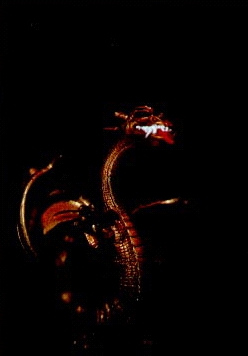
No fancy studio is needed to take pictures of your miniatures, as Darlene Blanchard discovered. Her husband took this picture of her (top left above), taking a picture of one of her favorite subjects, a great dragon. The beast is the focal point of another picture, taken with the AD&D™ Players Handbook as a backdrop (opposite page, top right). The rest of the photographs on these pages illustrate other special effects techniques the Florida woman discovered. The female magic user shown above, was captured in two shots, showing how cutting holes in inexpensive plastic can produce different effects. Dry ice is another way to make an ordinary picture more exciting: Above it is used with an army of skeletons (top) and in combination with the plastic diffusion filter that heightens a portrait of two lizardmen. On the opposite page, two more dragons are shown, one with a crinkle-cut piece of red plastic over the lens; the other with a Djinn and a cloud of dry ice mist (bottom). The other figures pictured on the page are a demon with a plain red filter (top left) and a Minataur with dry ice and aluminum foil in the background. that can be done to produce more interesting photos.”
Darlene Blanchard takes pictures of demons and dragons
—and her studio’s in her dining room.
The Tampa, Florida, woman hasn’t invented a new fantasy
role-playing game, like Sorcerers & Snapshots. But the highlevel
shutterbug has combined photography with two other
hobbies: fantasy gaming and miniatures painting.
The results are on these pages — and anyone with a camera,
some miniatures, and a little patience and imagination can
duplicate these fantasy photos, according to Darlene.
“It took some trial-and-error until I was satisfied with my
results, but it was a lot of fun,” she said. “I learned a great deal of
basic photography by experimenting with the lighting and various
special effects, and I know there are still many other things that can be done to produce more interesting photos."
Her interest in the ADVANCED DUNGEONS & DRAGONS® game came through her husband, Jim, who started her playing two and a half years ago. Miniatures painting followed, and it was natural to mix that with photography, which she’s pursued as an “advanced amateur” for more than six years.
“The first roll I did was really terrible,” she said. For her second attempt she “bracketed”— adjusting the camera to see what worked. “It’s real easy once you get the settings.”
Using finer-grained, “slow” color slide film (ASA 64), she adds two light sources: an electronic flash angled from one side and a floodlight from the other. She prefers 1/60th of a second shutter speed, with an aperture opening of f4.5 or f5.6. As for cameras, Darlene uses a 35mm with a 85-210mm zoom with close-focus ability, coupled with close-up filters. A 50mm lens with the close-up filters will also work, she says, as will more exotic — and expensive — equipment. A tripod and cable release help avoid blurry pictures caused by camera motion.
Using miniature figures means she doesn’t have to rent a full-sized dungeon for her shoots. A pile of sand, crinkled aluminum foil or piece of felt draped over a dining room chair is sufficient. Darlene also improvised with special effects. Cutting nickel-sized holes in translucent plastic held up to the lens made good diffusion filters. “You can buy filters like that with color spots and screw them into the lens, but this was a whole lot cheaper,” she said. “I think I paid 25 cents for the plastic.”
She achieved one of the most interesting effects with dry ice she got from her job as a medical technician in a toxicology lab. She puts the dry ice in a bowl of water off to the side, and when the initial bubbling subsides, a nice mist is produced.
Darlene also develops her own film. Besides saving money, she says, “you can take a look at what you have right away.”
In Darlene’s case, the looks are interesting, to say the least.